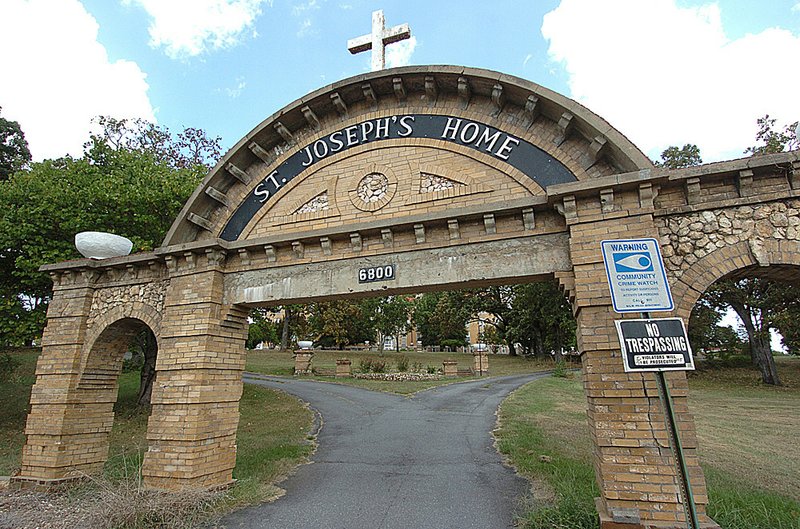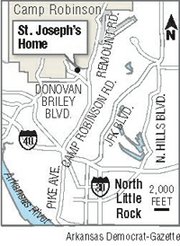LITTLE ROCK — A historic orphanage in North Little Rock will be an orphan no longer. A place thousands of youngsters once called home is itself getting a make-or-break chance at a new life.
A recent agreement will allow the St. Joseph Center of Arkansas Inc. to take over the century-old, former St.Joseph Orphanage property owned by the Diocese of Little Rock.
The site is to be restored for a still-undetermined use under a 50-year lease granted to the Catholic nonprofit group. The nonprofit has a year to present a plan for diocese approval.
The diocese announced more than two years ago that the 63-acre property would go up for sale if no one sought to preserve it for continued use. The property is on Camp Robinson Road near the Camp Pike portion of Camp Robinson.
The four-story, stone-and-yellow-brick building, built in 1910, later became the St. Joseph’s Home day care after the orphanage closed in 1978. The day care lasted until 1997.Until last month, the building has been used only for retreats by Catholic groups on weekends.
“It really was built to last, and it has,” said Kristy Eanes, secretary for the seven-member St. Joseph Center of Arkansas board of directors. “We want to come in and give it a new life really, a new lease on life.”
The group intends to commission a study of possible uses - and anticipated costs - for the entire property that would serve the community and carry on the Catholic mission, said Sandy DeCoursey, chairman of the St. Joseph Center board.
“We have a lot of different possibilities in mind,” DeCoursey said Wednesday. “Funding, of course, is a huge obstacle we will have to overcome.”
Eanes said any proposal “would be something in line with our church mission.”
“We really don’t know what the planning study will reveal,” she continued. “There are lots of ideas out there.”
The lease agreement calls for a proposed-uses plan to be ready by September 2011 when it will be reviewed by Bishop Anthony B. Taylor of the diocese. Any proposal would be subject to approval by the diocese.
It’s hoped that a preliminary proposal will be ready by early next year, DeCoursey said.
“Our first order of business is to study what will be the planned use on the whole property, not just the building,” DeCoursey said. “We’d love to restore it at some point. We’re not sure what we are being called to do yet. The study will determine what needs [in the community] are not being met so we can possibly fill a void.”
After the diocese decided in 2008 to sell the property, the St. Joseph Center formed with the mission to keep the property in service to the diocese and the community, DeCoursey said. The board signed the lease agreement early this month.
After the group and community leaders met, “It quickly became obvious that there was a great need for this sort of facility and what it would have to offer,” DeCoursey said.
“We’re looking at a spiritual nourishment center,” she added. “That’s what it has been used for in the last 10 years. It has been booked almost every weekend for the past two years. It is such a hallowed place.”
The 80-room, Italian villa style building that sits atop a hill was designed by Charles L. Thompson, a renowned local architect. Thompson was a forerunner to the Cromwell Architects Engineers firm in Little Rock, said Sandra Taylor-Smith, director of North Little Rock’s History Commission.
In 1910, the construction cost was $150,000, according to historical accounts. The orphanage opened in April 1910 to 66 children. Thousands more youths and more than 100 nuns would call St. Joseph home over the next few decades.
“It’s just a magnificent building,” said Taylor-Smith, who wrote the building’s nomination for the National Register of Historic Places in 1975. The distinction was granted the next year. “In winter, you can see the building on that crest from the Main Street Bridge [downtown]”
Black, veined marble is prominent inside on the floors and walls surrounded by oak woodwork and brass hearth covers, according to building descriptions. One focal point of the interior is its high-reaching, arched stained-glass windows.
Bishop John B. Morris established the orphanage to be run by Benedictine nuns. Except for about a three-year break during World War I, the orphanage operated continually until 1978.
With Camp Pike adjacent to the property, the U.S. Army for a time took over St. Joseph as housing for its military personnel and renamed it the Belmont Hotel. Morris relocated the children to a site in Little Rock that became the forerunner for Catholic High School, according to St. Joseph historical accounts.
When the nuns moved back with the children, they found partitions erected to create many more, smaller rooms. And there was one other notable change: “The small chapel had been converted into a barroom,” according to a July 1958 article in the Arkansas Democrat.
“It has a beautiful history, and we want to continue the original vision to help the community, to evangelize and to preserve the historic Catholic tradition of that place.
“The building itself is a holy place,” Eanes continued. “There is a reason why it was built on a hilltop. It was meant as sort of a beacon of hope, and you just really feel uplifted there. ... The placement of the building and all that space around it had a purpose.
“They don’t build them like that anymore.”
Arkansas, Pages 7 on 09/23/2010

